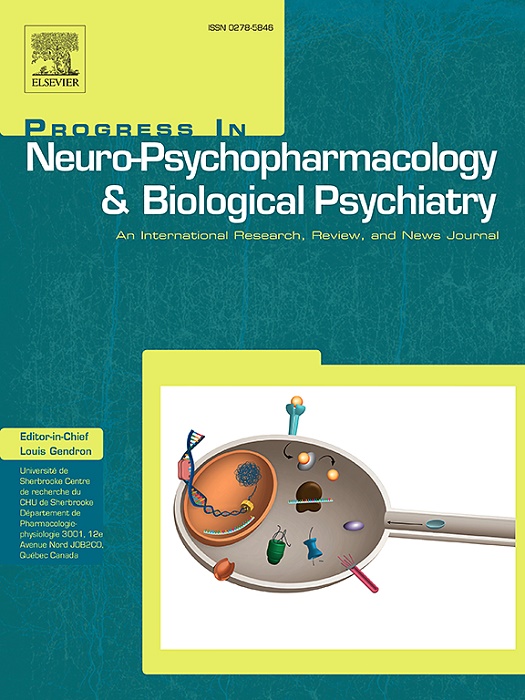Whole blood BDNF is lower in patients with depression and unchanged by escitalopram in patients and healthy controls
IF 3.9
2区 医学
Q1 CLINICAL NEUROLOGY
Progress in Neuro-Psychopharmacology & Biological Psychiatry
Pub Date : 2025-08-13
DOI:10.1016/j.pnpbp.2025.111470
引用次数: 0
Abstract
Background
Brain-derived neurotrophic factor (BDNF) plays a key role in neuroplasticity and has been implicated in both the pathophysiology of Major Depressive Disorder (MDD) and treatment effects. Unlike serum BDNF (s-BDNF), which largely reflects platelet-derived BDNF released during coagulation, whole blood BDNF (wb-BDNF) measures the total blood BDNF pool, minimizing confounds related to platelet aggregation. This study aims to assess whether wb-BDNF levels can serve as a biomarker for MDD and/or as a predictor of antidepressant treatment response.
Methods
We measured wb-BDNF before and after 4–12 weeks of escitalopram intervention in two studies: a non-randomized, single-arm clinical trial of 97 unmedicated patients with MDD and a randomized, double-blind, placebo-controlled trial with 66 healthy controls (HC). The BDNF Val65Met polymorphism was also determined.
Results
Unmedicated patients with MDD had 14 % lower wb-BDNF than HC, but wb-BDNF prior to intervention was not associated with symptom severity, nor did it predict drug treatment outcome in the patients. Further, improvements in depression scores after 8 and 12 weeks of escitalopram was not associated with changes in wb-BDNF. In HC, wb-BDNF was similar in the placebo and escitalopram groups after 4 weeks of intervention. BDNF polymorphism was similar between HC and MDD, and responders and non-responders, and was not associated with wb-BDNF levels.
Conclusion
wb-BDNF reflects the total blood BDNF pool and avoids platelet aggregation-related confounds seen in s-BDNF measures. wb-BDNF could be used as diagnosis but not as a prognosis biomarker, in MDD. Further research is needed to investigate changes in BDNF reservoirs and their implications.
抑郁症患者的全血BDNF较低,艾司西酞普兰对患者和健康对照组没有影响。
背景:脑源性神经营养因子(BDNF)在神经可塑性中起着关键作用,在重度抑郁症(MDD)的病理生理和治疗效果中都有涉及。血清BDNF (s-BDNF)主要反映凝血过程中血小板来源的BDNF释放,与之不同的是,全血BDNF (wb-BDNF)测量血液中总BDNF池,最大限度地减少与血小板聚集相关的混淆。本研究旨在评估wb-BDNF水平是否可以作为重度抑郁症的生物标志物和/或作为抗抑郁治疗反应的预测因子。方法:我们在两项研究中测量了艾司西酞普兰干预前后4-12 周的wb-BDNF:一项非随机、单臂临床试验,纳入97名未服药的重度抑郁症患者,另一项随机、双盲、安慰剂对照试验,纳入66名健康对照者(HC)。BDNF Val65Met多态性也被确定。结果:未服药的MDD患者的wb-BDNF比HC患者低14 %,但干预前的wb-BDNF与症状严重程度无关,也不能预测患者的药物治疗结果。此外,服用艾司西酞普兰8周和12 周后抑郁评分的改善与wb-BDNF的变化无关。在HC中,干预4 周后,安慰剂组和艾司西酞普兰组的wb-BDNF相似。BDNF多态性在HC和MDD、应答者和无应答者之间相似,与wb-BDNF水平无关。结论:wb-BDNF反映了总血BDNF池,避免了s-BDNF测量中出现的血小板聚集相关混淆。wb-BDNF可作为重度抑郁症的诊断指标,但不能作为预后指标。需要进一步研究BDNF储层的变化及其影响。
本文章由计算机程序翻译,如有差异,请以英文原文为准。
求助全文
约1分钟内获得全文
求助全文
来源期刊
CiteScore
12.00
自引率
1.80%
发文量
153
审稿时长
56 days
期刊介绍:
Progress in Neuro-Psychopharmacology & Biological Psychiatry is an international and multidisciplinary journal which aims to ensure the rapid publication of authoritative reviews and research papers dealing with experimental and clinical aspects of neuro-psychopharmacology and biological psychiatry. Issues of the journal are regularly devoted wholly in or in part to a topical subject.
Progress in Neuro-Psychopharmacology & Biological Psychiatry does not publish work on the actions of biological extracts unless the pharmacological active molecular substrate and/or specific receptor binding properties of the extract compounds are elucidated.

 求助内容:
求助内容: 应助结果提醒方式:
应助结果提醒方式:


